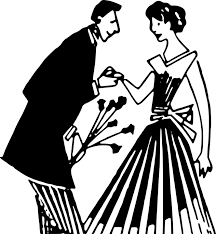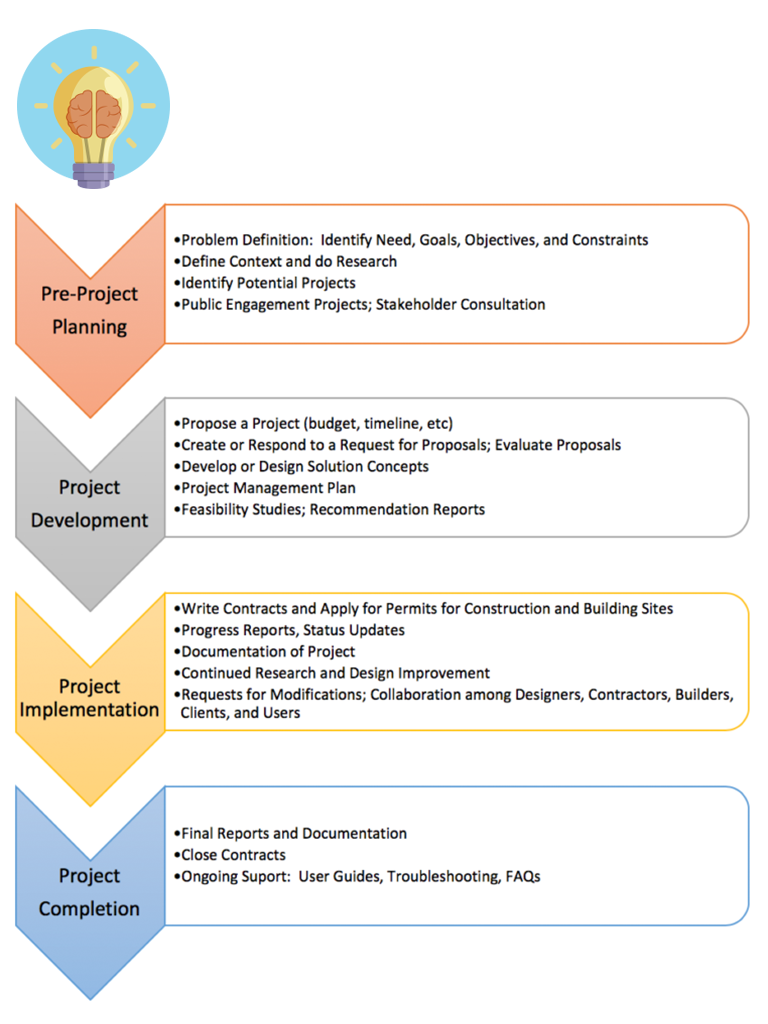7. COMMON DOCUMENT TYPES
7.2 Proposals
Proposals and progress reports are some of the most common types of reports you will likely find yourself writing in the workplace. These reports are persuasive in nature: proposals attempt to persuade the reader to accept the writer’s proposed idea; progress reports assure the reader that the project is on time and on budget, or explain rationally why things might not be going according to the initial plan.
A proposal, in the technical sense, is a document that tries to persuade the reader to implement a proposed plan or approve a proposed project. Most businesses rely on effective proposal writing to ensure successful continuation of their business and to get new contracts. The writer tries to convince the reader that the proposed plan or project is worth doing (worth the time, energy, and expense necessary to implement or see through), that the author represents the best candidate for implementing the idea, and that it will result in tangible benefits.

Proposals are often written in response to a Request For Proposals (RFP) by a government agency, organization, or company. The requesting body receives multiple proposals responding to their request, reviews the submitted proposals, and chooses the best one(s) to go forward. Thus, your proposal must persuade the reader that your idea is the one most worth pursuing. Proposals are persuasive documents intended to initiate a project and get the reader to authorize a course of action proposed in the document. These might include proposals to
- Perform a task (such as a feasibility study, a research project, etc.)
- Provide a product
- Provide a service
Proposals can have various purposes and thus take many forms. It may include sections such as the following:
- Introduction and/or background
- Problem statement
- Purpose/motivation/goal/objectives
- Definition of scope and approach
- Review of the state of the art
- Technical background
- Project description
- Schedule of work/timeline
- Budget
- Qualifications
- Conclusion
Four Kinds of Proposals
- Solicited Proposals: an organization identifies a situation or problem that it wants to improve or solve and issues an RFP (Request for Proposals) asking for proposals on how to address it. The requesting organization will vet proposals and choose the most convincing one, often using a detailed scoring rubric or weighted objectives chart to determine which proposal best responds to the request.
- Unsolicited Proposals: a writer perceives a problem or an opportunity and takes the initiative to propose a way to solve the problem or take advantage of the opportunity (without being requested to do so). This can often be the most difficult kind of proposal to get approved.
- Internal Proposals: these are written by and for someone within the same organization. Since both the writer and reader share the same workplace context, these proposals are generally shorter than external proposals, and usually address some way to improve a work-related situation (productivity, efficiency, profit, etc.). As internal documents, they are often sent as memos, or introduced with a memo if the proposal is lengthy.
- External Proposals: these are sent outside of the writer’s organization to a separate entity (usually to solicit business). Since these are external documents, they are usually sent as a formal report (if long), introduced by a cover letter (letter of transmittal). External proposals are usually sent in response to a Request for Proposals, but not always.
EXERCISE 7.1 Task Analysis
Identify the kinds of proposals your Report 1 and Report 2 assignments ask you to write by placing them within the grid below. Given the kinds of proposals you must write, what forms will you use (memo, letter, report, etc.)?
| Solicited | Unsolicited | |
| Internal | ||
| External |
Proposals written as an assignment in a Technical Writing classes generally do the following:
- Identify and define the problem that needs to be solved or the opportunity that can be taken advantage of. You must show that you clearly understand the problem/situation if you are to convince the reader that you can solve it. Rubrics that assess proposals generally place significant weight (~20%) on clarity and accuracy of the problem definition.
- Describe your proposed project, clearly defining the scope of what you propose to do. Often, it is best to give a general overview of your idea, and then break it down into more detailed sub-sections.
- Indicate how your proposed solution will solve the problem and provide tangible benefits. Specifically, indicate how it will meet the objectives and abide by the constrains outlined in the problem definition. Give specific examples. Show the specific differences between “how things are now” and “how they could be.” Be as empirical as possible, but appeal to all appropriate persuasive strategies. Emphasize results, benefits, and feasibility of your proposed idea.
- Include the practical details: propose a budget and a timeline for completing your project. Represent these graphically (budget table, and Gantt chart). Your timeline should include the major milestones or deliverables of the project, as well as dates or time frames for completion of each step.
- Conclude with a final pitch that summarizes and emphasizes the benefits of implementing your proposed idea – but without sounding like an advertisement.
Additional Proposal Elements to Consider
- Describe your qualifications to take on and/or lead this project; persuade the reader that you have the required skills, experience, and expertise to complete this job.
- Decide what graphics to use to illustrate your ideas, present data, and enhance your pitch.
- Include secondary research to enhance your credibility and the strength of your proposal.
- Choose format; is this a memo to an internal audience or a formal report to an external audience? Does it require a letter of transmittal?
All proposals must be convincing, logical, and credible, and to do this, they must consider audience, purpose and tone.
Irish and Weiss[2] urge readers to keep the following in mind:
An engineering proposal is not an advertisement. It must show, with objective language, clarity, and thoroughness, that the writers know what they are doing and will successfully complete the project.
Sample Proposal Organization
Each proposal will be unique in that it must address a particular audience, in a particular context, for a specific purpose. However, the following offers a fairly standard organization for many types of proposals:
| Introduction/Background |
Clearly and fully defines the problem or opportunity addressed by the proposal, and briefly presents the solution idea; convinces the reader that there is a clear need, and a clear benefit to the proposed idea. |
| Project Description |
Detailed description of solution idea and detailed explanation of how the proposed idea will improve the situation:
|
| Credentials |
Establish writer’s qualifications and experience to lead this project. |
| Timeline and Budget |
Provide a detailed timeline for completion of project (use a Gantt chart to indicate when each stage of the project will be complete). Provide an itemized budget for completing the proposed project. |
| Conclusion |
This is your last chance to convince the reader; be persuasive! |
| References |
List your research sources. |
Language Considerations
Proposals are fundamentally persuasive documents, so paying attention to the rhetorical situation—position of the reader (upward, lateral, downward or outward communication), the purpose of the proposal, the form, and the tone—is paramount.
- Clearly define your purpose and audience before you begin to write
- Be sure you have done research so you know what you are talking about
- Remain positive and constructive: you are seeking to improve a situation
- Be solution oriented; don’t blame or dwell on the negative
- Make your introduction very logical, objective, and empirical; don’t start off sounding like an advertisement or sounding biased; avoid logical fallacies
- Use primarily logical and ethical appeals; use emotional appeals sparingly
As always, adhere to the 7 Cs by making sure that your writing is
- Clear and Coherent: don’t confuse your reader with unclear ideas or an illogically organized structure.
- Concise and Courteous: don’t annoy your reader with clutter, unnecessary padding, inappropriate tone, or hard-to-read formatting.
- Concrete and Complete: avoid vague generalities; give specifics. Don’t leave out necessary information.
- Correct: don’t undermine your professional credibility by neglecting grammar and spelling, or by including inaccurate information.
The Life Cycle of a Project Idea
A great idea does not usually go straight from proposal to implementation. You may think it would be a great idea to construct a green roof on top of the Clearihue building, but before anyone gives you the go ahead for such an expensive and time-consuming project, they will need to know that you have done research to ensure the idea is cost effective and will actually work. Figure 7.2.1 breaks down the various stages a project might go through, and identifies some of the typical communications tasks that might be required at each stage.
Most ideas start out as a proposal to determine if the idea is really feasible, or to find out which of several options will be most advantageous. So before you propose the actual green roof, you propose to study whether or not it is a feasible idea. Before you recommend a data storage system, you propose to study 3 different systems to find out which is the best one for this particular situation. Your proposal assumes the idea is worth looking into, convinces the reader that it is worth spending the time and resources to look into, and gives detailed information on how you propose to do the “finding out.”

Once a project is in the implementation phase, the people who are responsible for the project will likely want regular status updates and/or progress reports to make sure that the project is proceeding on time and on budget, or to get a clear, rational explanation for why it is not. To learn more about Progress Reports, go to 7.3 Progress Reports.
Image descriptions
Figure 7.2.1 image description:
Once there is an idea, a project goes through a design process made up of four stages.
- Pre-project planning.
- Problem Definition – identifying needs, goals, objectives, and constraints.
- Define context and do research.
- Identify potential projects.
- Public engagement projects; Stakeholder consultation.
- Project Development.
- Propose a project (budget, timeline, etc.).
- Create or respond to a request for proposals, evaluate proposals.
- Develop or design solution concepts.
- Project management plan.
- Feasibility Studies, Recommendation Reports).
- Project Implementation.
- Write contracts and apply for permits for construction and building sites.
- Progress reports, status updates.
- Documentation of project.
- Continued research and design improvements.
- Project completion.
- Final reports and documentation.
- Close contracts.
- Ongoing Support: User Guides, Troubleshooting, FAQs.
- [Proposal image]. [Online]. Available: https://pixabay.com/en/couple-love-marriage-proposal-47192/. Pixabay License. ↵
- R. Irish and P. Weiss, Engineering Communication: From Principle to Practice, 2nd Ed., Don Mill, ONT: Oxford UP, 2013. ↵
- [Lightbulb image]. [Online]. Available: https://www.iconfinder.com/icons/667355/aha_brilliance_idea_think_thought_icon. Free for commercial use. ↵

